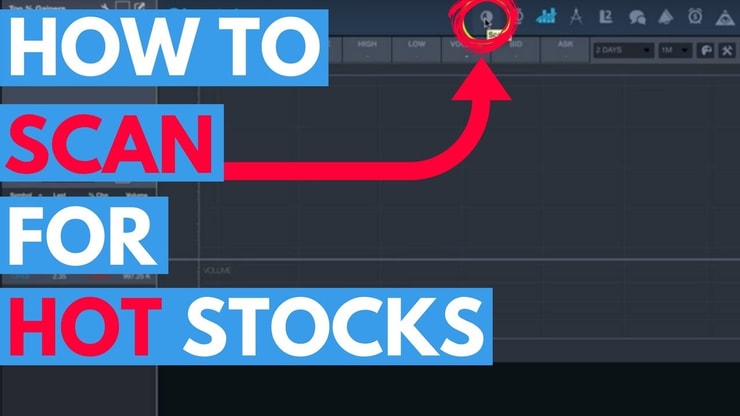You know that feeling when you see the stock market take a sudden jump or dive, and you’re not quite sure why it happened?
If so, you need to learn trend analysis now. I know, I know. So technical. So … analytic. But this is important. This can help you make far better sense of the market.
Trend analysis is a great way to predict how the market might move in the future, and it can you help tip the odds in your favor when it comes to trading.
In this article, I’ll break down trend analysis, how and why to use it, as well as how to identify and predict trends for yourself. I’ll also share some essential trend analysis tips for day traders.
Table of Contents
What Is Trend Analysis?
Trend analysis is a technical analysis technique and also considered a type of comparative analysis.
The goal of trend analysis is to use past data to predict the future movements of stock prices.
It’s pretty straightforward … A trend is the overall direction that the market seems to be moving in over a given period. As a stock trader, what’s happened in the past can give you a solid idea of what to expect from a stock in the future.
Investors look at short-, intermediate-, and long-term trends. They use trend analysis in an attempt to identify bull runs in the market and find trend reversals that show it might take a downturn.
Both upward and downward trends can be identified by using trend analysis.
A huge part of trading is psychological — going with the trends, instead of against them, can help boost an investor’s profit margin.
Trend analysis looks at a stock’s historical data. It also accounts for multiple other factors, like competition, market conditions, and general changes to the sector.
Benefits of Using Trend Analysis
Trend analysis can help you pick optimum times to enter and exit stock positions — helping you become an overall better trader.
It’s also beneficial for spotting early warning signs. Careful trend analysis can sometimes help a trader spot potential problems before they become widely known.
If you spot a dip in a trend where there’s no reason to expect one, that’s your cue! Dig deeper and find the culprit.
That’s the importance of trend analysis — it helps put you ahead of the curve.
Of course, a smart trader will consider lots of other factors, like a company’s financial conditions. But trend analysis is another valuable asset to add to your toolkit.
How to Conduct Trend Analysis

2025 Millionaire Media, LLCSo now you understand why trend analysis can be useful for traders. It’s almost like having a crystal ball that can give you a better chance at predicting how a stock will behave in the future.
Ready to learn how to do trend analysis for yourself?
First, you’ll need to pick which market segment you want to analyze. Then you’ll look at the general performance of the market you select.
Determine Which Market Segment Will Be Analyzed
Before you can start doing trend analysis, you need to first decide which market segment you want to analyze …
A market segment doesn’t have to be industry specific, like pharmaceuticals or automotive. You can also use trend analysis to look at different types of investments as a whole, like the bond market or REITs (real estate investment trusts).
Once you pick your sector, it’s time to look at its general performance. That includes anything that can affect it — new government regulations, shortages of a specific raw material, and so on.
Next, you’ll use this data for market trend analysis to predict how the market will move in the future. You’re mostly looking for the overall direction, whether up or down, over a specific future time period.
More Breaking News
- BitMine Immersion Tech Sees Tremendous Stock Rally Amid Q3 Revenue Surge
- Bit Digital’s New Ethereum Focus: Game-Changer?
- RXRX Shares Plunge: Market Opportunity?
Analyze the General Performance of the Selected Market
The most common time frames to analyze the performance of a market over are month by month or year over year.
Monthly trends show how a market or individual stock performs from one month to the next. What that doesn’t account for: seasonality. And that can be key depending on the market.
A year-over-year analysis can give a more accurate comparison. Instead of looking at how the market performed in September compared to August, you instead compare September of this year to September of last year.
Let’s say the market you’re studying is swimming pool manufacturers, and there’s a steep drop in demand for swimming pools once the summer ends. If you look only at monthly trends, you might think the market is performing poorly once autumn arrives.
But comparing performance between this year and last year can give you a much better perspective.
Overall, year-over-year trends can be better predictors of future market activity. It gives most of the benefits of comparing month to month but eliminates variabilities like seasonality.
3 Steps to Help You Identify Trends

2025 Millionaire Media, LLCOK, so now you know how to analyze the general performance of a market. But how do you identify changes in trends? That’s where trend analysis is instrumental.
There are three trend-analysis methods and tools I use to identify trends …
#1 News Catalysts
A news catalyst is any kind of event or revelation that can cause a dramatic change in the price of a stock or markets as a whole.
A news catalyst can be basically anything that a trader can interpret as good or bad news. That can include things like:
- New government legislation
- Earnings reports exceeding or falling short of expectations
- An analyst revision
- A new product announcement
- A lawsuit
- War or civil unrest
- Mergers or acquisitions
- Or even just an off-hand comment made by a CEO!
A news catalyst doesn’t always have an immediate effect on a market or a stock’s fundamentals. It can either excite or rattle investors — driving a market up or down.
Different investors will assign different levels of value to news catalysts. Value investors usually completely ignore news catalysts and focus on the fundamentals of a market or company.
Momentum investors are the opposite. They make the majority of their trading decisions based on news events.
The majority of investors aren’t on either extreme but fall somewhere in the middle. A shrewd trader might focus most of their attention on fundamentals, but admit that major news events can have an effect on a market.
#2 Stock Screeners
One of my favorite market trend analysis tools is a stock screener.
This tool allows you to filter stocks — by sector, industry, performance, valuation, dividends, average volume, margins, income statement, and balance sheet. You can also separate out small-, mid-, or large-cap stocks.
In a nutshell, you can set your own metrics, and a stock screener will display stocks that fit your specific criteria.
Stock screeners can either be free or require a subscription, depending on which website or trading platform you’re using.
The free screeners are very useful, but paid versions often include extra features. For example, some platforms might let you screen using technical indicator data like RSI (relative strength index) values or a 200-day moving average.
Stock screeners are an excellent tool for both investors and active traders. They can identify both stocks that look primed to perform well in the long term, as well as potential setups for short-term positions.
Screeners make it easy to analyze hundreds of stocks in a very short period by efficiently weeding out those that don’t meet your requirements.
#3 Stock Indicators
Indicators are statistics that measure current market conditions and also forecast potential economic or financial trends.
We can break indicators down into two main categories: technical and economic.
Technical Indicators
These indicators are some of the main tools used in technical analysis to predict how the price of a stock will trend. They use mathematical calculations based mainly on historical trading data like price and volume.
An example of a technical indicator is the relative strength index (RSI), which determines an asset’s price momentum by comparing the size of recent gains to recent losses.
Another example is the moving average convergence-divergence (MACD), which attempts to find a trend line by looking at moving averages for a stock over different time periods.
Technical indicators are displayed in two main ways …
The first is in overlays, like moving averages or Bollinger Bands©, which are plotted on top of a stock chart.
The second is as oscillators, like RSI and MACD, which are plotted above or below a stock chart.
There’s no one set method. Traders often combine multiple technical indicators to analyze stocks. You can choose from thousands of different technical-indicator combinations to find what works best for your needs.
Economic Indicators
These indicators can measure sectors of the economy or the entire economy, and can mark growth or contraction.
Examples of economic indicators include data presented by the Department of Labor or the Institute of Supply Management (ISM).
Housing and real estate are also leading economic indicators, which are measured using the NAHB/Wells Fargo Housing Market Index (HMI) and S&P/Case-Shiller Index. These both measure the market for new homes and housing price data respectively.
Other economic indicators include consumer sentiment, as well as the money supply and interest rates set by the Federal Reserve.
Key Trend Analysis Tips for Day Traders

2025 Millionaire Media, LLCReady to try using trend analysis as a tool for day trading? Check out these tips …
Don’t Trade Too Big
Always avoid taking on more risk than you can handle. That’s especially true when you add something new to your stock-trading repertoire.
Trends can reverse suddenly and wildly, leaving you in a terrible position if you’re not careful. That’s why I recommend having a stop-loss in place to help you cut losses if things take an unexpected turn.
Start small — especially while you’re new and still experimenting with trend analysis as part of your day trading.
Develop a Stock Watchlist
A stock watchlist gives you one consolidated view that shows you the overall performance of all the stocks you’re currently following.
After you use a stock screener, it’s a good idea to add any stocks that meet your criteria to your watchlist. It’s a convenient way to check on the performance of all the stocks you follow at once. The alternative? Manually look up each ticket every time you want to check on a stock.
Stock watchlists let you list all your holdings and potential purchases in one place. There’s no shortage of options — plenty of free watchlists are available. You can sort, click, drag, and drop, and more. Find and use whatever best meets your personal needs.
Check out this stock watchlist guide to learn how to make your own watchlist, if you don’t already have one. (You can also take a look at my personal weekly watchlist.)
Stick to Your Trading Plan
I often discuss the importance of a clearly laid out trading plan.
A trading plan is all yours. It’s your set of rules that help you invest. Before you enter or exit any security, it must meet the rules that you set in advance.
Your trading plan might include your risk level, goals, entry rules, and exit rules. And there are the basics that you set for yourself, like keeping good records.
Having a trading plan can help you avoid emotional reactions to the performance of both individual stocks and the market as a whole. And it can help put your personal bias into perspective.
Learn With Stock Market Professionals
You don’t have to learn trend analysis through trial and error. There are plenty of great free and paid courses out there to help you on your journey.
You’re already taking a significant step in the right direction by reading my articles. But what if you’re ready to speed up the process?
If you’re tired of losing money by trying to trade on your own, apply to join my Trading Challenge. It can help you accelerate your education and avoid learning the hard way from your mistakes.
The Bottom Line
Trend analysis is a technique that can help you use past behavior of the market or an individual stock to predict where it might be headed in the future.
Put this tool to work for your own trades: Conduct trend analysis on your own trades and fave stocks, or use it to identify new trends.
When it comes to the stock market, there are no guarantees. But I hope this knowledge will help you tip the odds in your favor.
Has trend analysis helped your trading before? What happened? Share your story here!






Leave a reply